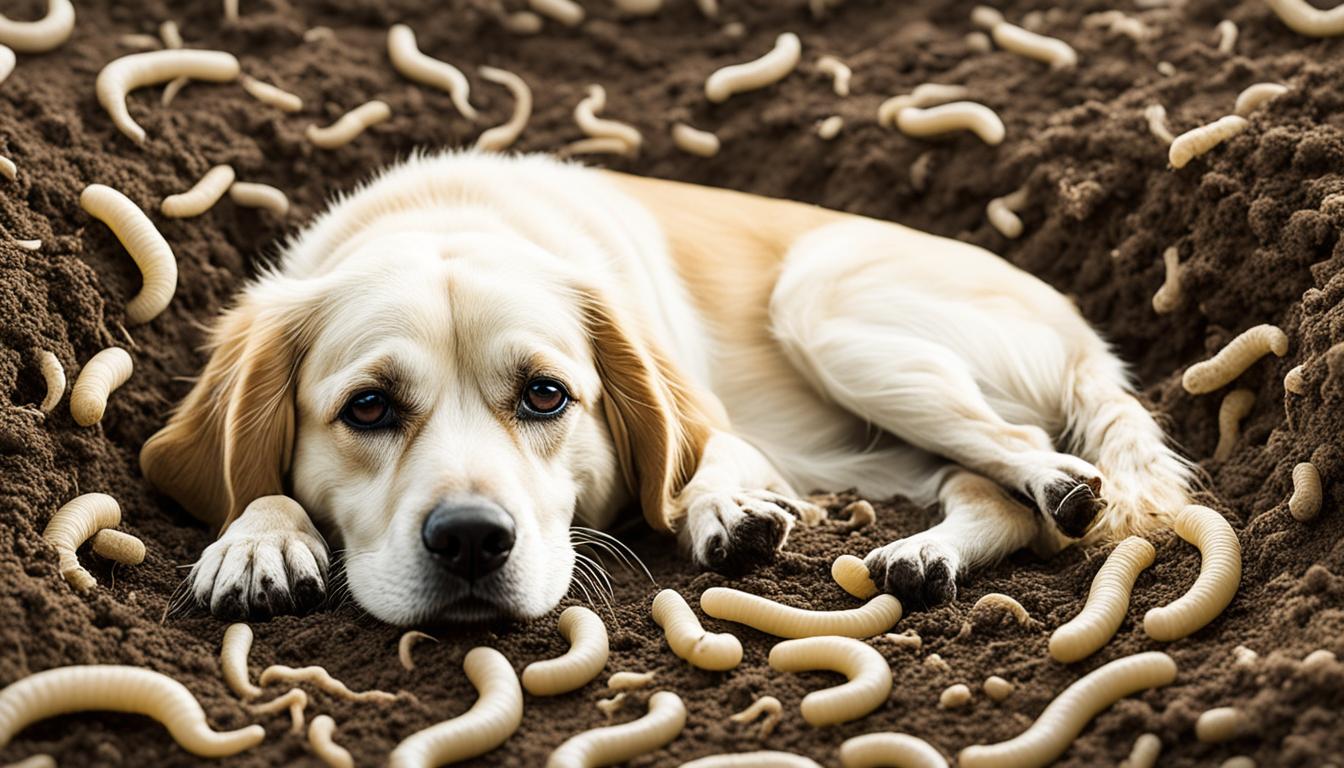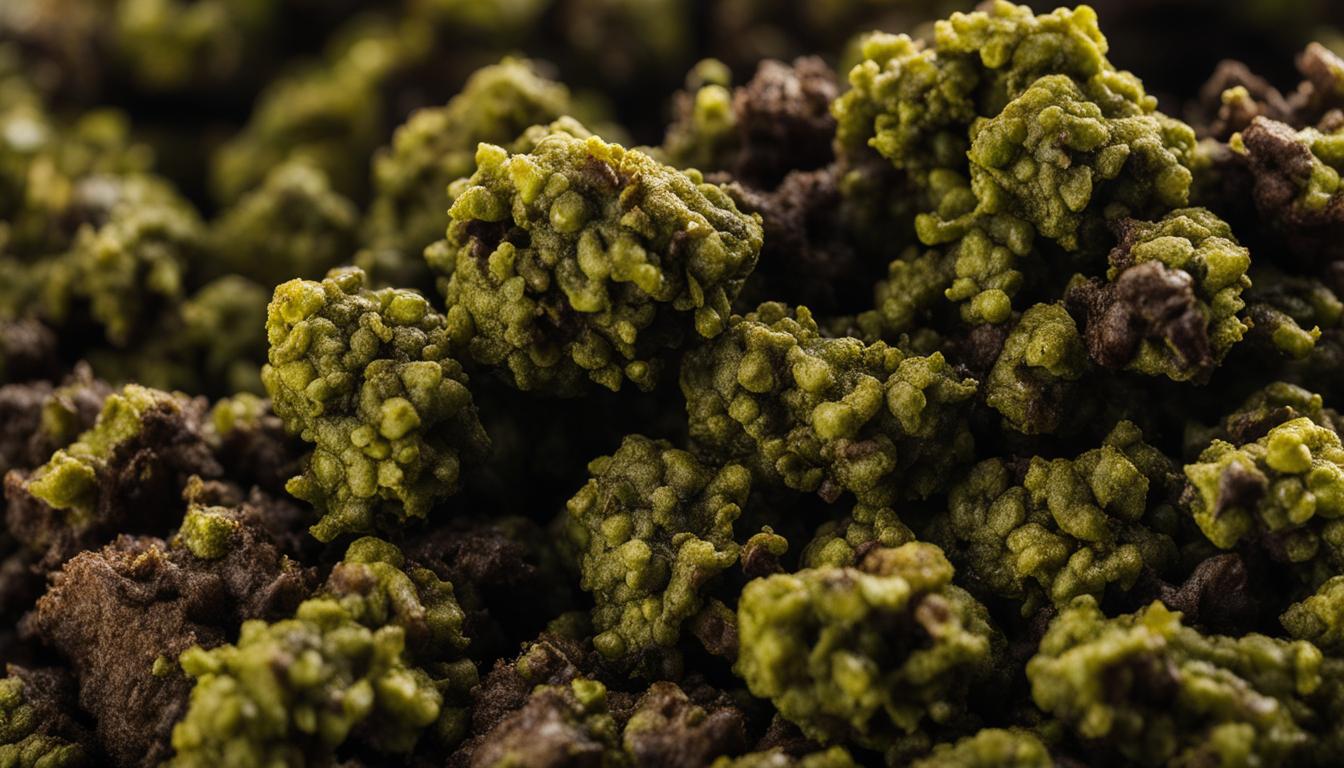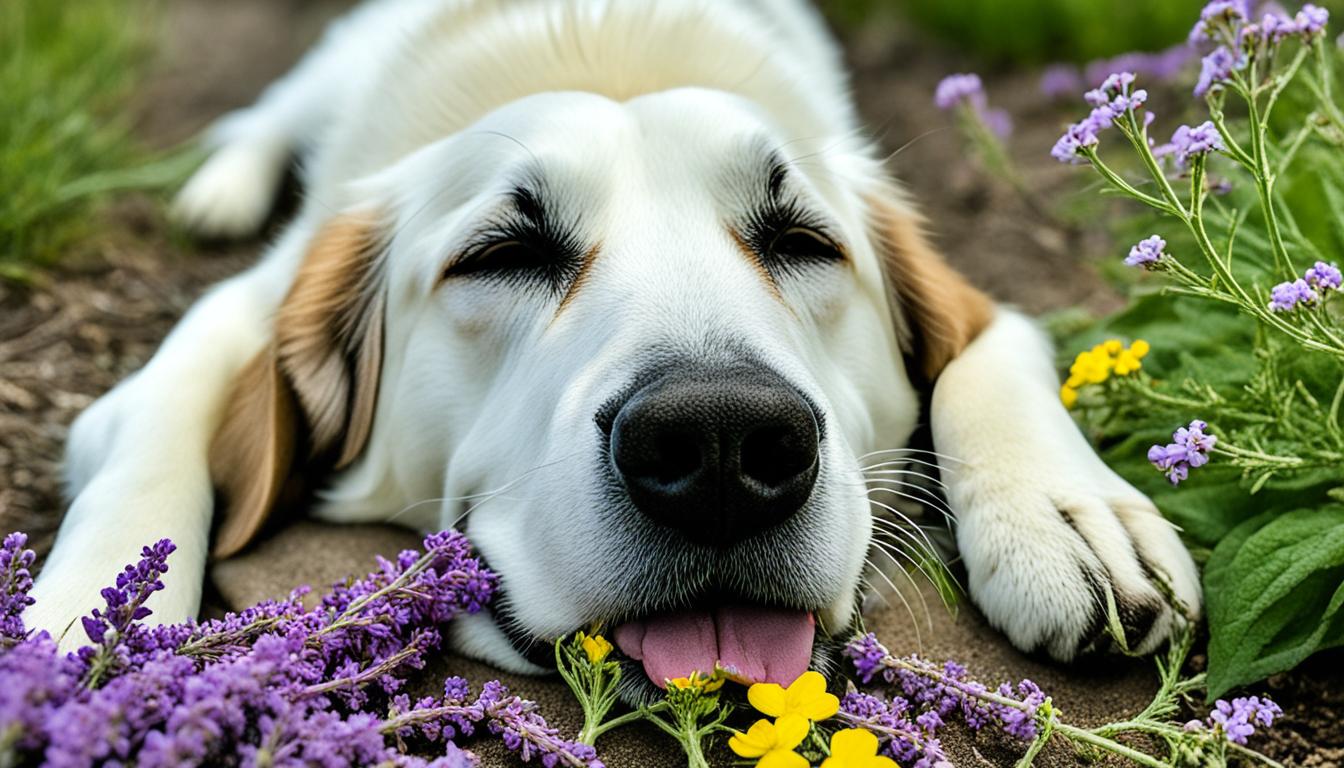Hookworm infection in dogs is a common and serious health issue that affects the intestines of our beloved pets. These small parasitic worms attach themselves to the lining of a dog’s intestines and feed on their blood, causing inflammation and anemia. The infection can be transmitted through various routes, including oral ingestion, skin contact, in utero transmission, and through the mother’s milk.
Overcrowding and poor sanitation contribute to the spread of hookworms, making it crucial for dog owners to be aware of the symptoms, treatment options, and prevention measures. Recognizing the signs of hookworm infection, such as anemia, pale gums, weakness, weight loss, bloody diarrhea, and skin irritation, is essential for prompt diagnosis and treatment by a veterinarian.
Key Takeaways:
- Hookworms are small intestinal parasites that feed on the blood of dogs, causing inflammation and anemia.
- Dogs can get hookworms through various routes, including oral ingestion, skin contact, in utero transmission, and through the mother’s milk.
- Symptoms of hookworm infection include anemia, pale gums, weakness, weight loss, bloody diarrhea, and skin irritation.
- A fecal flotation test is used to diagnose hookworm infection in dogs.
- Treatment involves the use of anthelmintic drugs, while prevention includes deworming puppies, proper disposal of dog feces, good hygiene practices, and using heartworm prevention products that also target hookworms.
What are Hookworms?
Hookworms are intestinal parasites found in cats and dogs. These parasites have hook-like mouthparts and measure approximately 1/4″ to 3/4″ in size. They primarily reside in the small intestines of infected animals and survive by feeding on blood from the host’s intestinal wall. This feeding process can lead to inflammation and anemia in the affected animals.
Canine hookworms are more commonly found in warm and moist environments, making them prevalent in certain regions. They are also frequently encountered in dogs that are kept in overcrowded and unsanitary conditions, where the risk of transmission is higher.
Female hookworms produce microscopic eggs, which are passed through the dog’s feces, thereby contaminating the surrounding environment. These eggs hatch into larvae that remain infective in the soil for weeks to months. Dogs can become infected by ingesting these infective hookworm larvae through various routes, including grooming, sniffing feces, or contact with contaminated soil.
Once inside the dog’s body, the larvae migrate to the intestines, where they mature into adult hookworms. This completes their life cycle, allowing them to reproduce and continue the infection cycle.
Causes of Hookworm Infection in Dogs
Dogs can acquire hookworms through various means, including oral ingestion, skin contact, in utero transmission, and via the mother’s milk. These routes of transmission can lead to hookworm infestation and pose a significant health risk for dogs.
Oral ingestion: Hookworm larvae can enter a dog’s system if they accidentally swallow these microscopic parasites while grooming or sniffing contaminated soil or feces. It is crucial to prevent dogs from coming into contact with areas where hookworm larvae are present to reduce the risk of ingestion.
Skin contact: Another way dogs can become infected with hookworms is through skin contact. When dogs lie on contaminated ground, the larvae can burrow into their skin, making their way to the intestines to complete their life cycle. Preventing dogs from lying on or playing in hookworm-infested areas can help mitigate this risk.
In utero transmission: Pregnant dogs with previous hookworm infections can reactivate dormant larvae that have been present in their bodies. These reactivated larvae then travel to the uterus, infecting the developing puppies. This mode of transmission highlights the importance of treating female dogs for hookworms before and during pregnancy to prevent the transmission of larvae to the next generation.
Mother’s milk: Puppies can also contract hookworms through their mother’s milk. If a lactating mother dog has an active hookworm infection, the larvae can be present in her milk, exposing the nursing puppies to infection. Regular deworming of nursing mothers can help prevent transmission through this route.
Additionally, it is worth noting that dogs can even become infected if they eat a transport host that carries infective hookworm larvae. For example, if a dog ingests a cockroach carrying hookworm larvae, it can lead to transmission and subsequent infestation.
| Transmission Routes | Prevention Measures |
|---|---|
| Oral ingestion | – Avoiding contact with contaminated soil and feces – Regular grooming and cleaning practices |
| Skin contact | – Preventing dogs from lying on hookworm-infested ground – Frequent bathing and grooming |
| In utero transmission | – Deworming pregnant dogs before and during pregnancy – Veterinary supervision during the gestation period |
| Mother’s milk | – Regular deworming of lactating mothers – Monitoring the health of nursing puppies |
| Eating transport host | – Controlling pests in and around the dog’s environment – Preventing access to potential transport hosts |
Understanding these various routes of hookworm transmission is essential for dog owners to take proactive measures to protect their pets from hookworm infection.
Symptoms of Hookworm Infection in Dogs
The clinical signs of hookworm infection in dogs are primarily related to intestinal distress and anemia. Dogs with hookworms may experience various symptoms that can be indicators of the infection. These symptoms include:
- Pale gums: Hookworms feed on blood from the intestinal wall, resulting in anemia and pale gums.
- Weakness: The loss of blood and nutrients due to hookworm feeding can cause weakness and lethargy in infected dogs.
- Weight loss: Because hookworms consume blood and essential nutrients, infected dogs may experience significant weight loss.
- Bloody diarrhea: Hookworm infestation can lead to inflammation and damage to the intestinal wall, resulting in bloody diarrhea.
- Dull coat: The combination of poor nutrition and anemia can result in a dull and lackluster coat.
- Failure to grow properly: In puppies, hookworm infection can interfere with proper growth and development.
In severe cases, hookworm infections can be life-threatening, especially in young puppies who are more vulnerable to the effects of anemia. Additionally, heavy infestations of hookworm larvae can cause skin irritation and itching, particularly in the paw area.
In severe cases, dogs may also experience coughing, as hookworm larvae can migrate to the lungs and cause respiratory distress.
Consulting a Veterinarian
If any of these symptoms are observed in a dog, it is important to consult a veterinarian. A veterinarian will be able to accurately diagnose the presence of hookworm infection through various diagnostic methods, such as a fecal flotation test, and provide appropriate treatment options.
In the words of Dr. Smith, a renowned veterinarian specializing in parasitic diseases, “Early detection and treatment are crucial in managing hookworm infections in dogs. Regular check-ups and prompt veterinary care can significantly improve the prognosis for infected dogs.”
| Symptoms | Severity |
|---|---|
| Pale gums | Mild to severe |
| Weakness | Mild to severe |
| Weight loss | Mild to severe |
| Bloody diarrhea | Mild to severe |
| Dull coat | Mild to moderate |
| Failure to grow properly | Mild to moderate |
| Skin irritation and itching | Mild to severe |
| Coughing | Mild to severe |
Diagnosing Hookworm Infection in Dogs
Diagnosing hookworm infection in dogs is crucial for prompt treatment and containment of the infection. The primary diagnostic method used by veterinarians is the fecal flotation test. This test involves collecting a stool sample from the dog and mixing it with a special solution that causes hookworm eggs to float to the top, making them visible on a glass slide. The eggs have a distinctive appearance, with a transparent shell and a coiled embryo inside. The presence of these eggs confirms the diagnosis of hookworm infection.
The fecal flotation test is a reliable diagnostic tool because hookworms produce large quantities of eggs daily, making them easily detectable. However, it’s important to note that this test may be less reliable in very young puppies. In young puppies, it takes time for the larvae to mature and start producing eggs. Therefore, if a young puppy tests negative for hookworms, it may still be infected, and further testing may be necessary.
“The fecal flotation test is a reliable diagnostic tool because hookworms produce large quantities of eggs daily, making them easily detectable.”
It’s important to understand that adult hookworms are rarely detected in stool samples. This is because adult hookworms firmly attach themselves to the intestinal wall, making them difficult to dislodge and detect. However, the presence of eggs in the stool indicates an active infection and the need for treatment.
In summary, the fecal flotation test is the primary method used to diagnose hookworm infection in dogs. It is a reliable and effective diagnostic tool, although its accuracy may be lower in very young puppies. Prompt diagnosis and treatment are essential to prevent the spread of hookworms and ensure the health and well-being of infected dogs.
| Advantages of Fecal Flotation Test for Hookworm Diagnosis | Disadvantages of Fecal Flotation Test for Hookworm Diagnosis |
|---|---|
| Easily detects hookworm eggs | May be less reliable in very young puppies |
| Can confirm an active hookworm infection | Does not detect adult hookworms |
| Helps guide appropriate treatment | – |
Treatment for Hookworms in Dogs
When it comes to tackling hookworm infections in dogs, several anthelmintic drugs have proven to be effective. These medications can be administered orally and generally have minimal side effects. However, it’s important to note that these drugs primarily target adult hookworms, and additional treatment is necessary to address any new adult worms that were larvae during the initial treatment. Ideally, the treatment should be repeated in two to three weeks to ensure complete eradication of the infection.
In severe cases of anemia resulting from hookworm infection, a blood transfusion may be required. This critical intervention helps restore the red blood cell count and combat the effects of blood loss caused by hookworms.
Throughout the treatment process, it is crucial to consult with a veterinarian who can provide a proper diagnosis and guidance on the most appropriate and effective treatment options for hookworm infections in dogs.
| Treatment Approach | Description |
|---|---|
| Anthelmintic Drugs | Orally administered medications that target adult hookworms. |
| Multiple Treatments | Repeating the treatment in two to three weeks to eliminate new adult worms that were larvae during the first treatment. |
| Blood Transfusion | A critical intervention for severe cases of anemia caused by hookworm infection, helping restore the red blood cell count. |
By following the appropriate treatment protocol and working closely with a veterinarian, dog owners can effectively combat hookworm infections and ensure the health and well-being of their beloved pets.
Prevention of Hookworm Infection in Dogs
Preventing hookworm infection in dogs requires a proactive approach that includes several preventive measures. By following these essential steps, you can safeguard the health and well-being of your beloved pets while minimizing the risk of hookworm transmission.
All puppies should be treated with a veterinary-approved anthelmintic product at two to three weeks of age. This early intervention helps eliminate any existing hookworm larvae, preventing further infestation. It is crucial to consult with a veterinarian to determine the appropriate anthelmintic treatment for your puppies.
Prompt removal and disposal of dog feces play a pivotal role in reducing environmental contamination. Especially in yards, playgrounds, and public parks, it is essential to clean up after your dog. Disposing of dog waste properly not only prevents the spread of hookworm larvae but also maintains a hygienic environment for all.
To protect against human infections, strict hygiene practices are imperative. Frequent handwashing and bathing help minimize the risk of transmission from dogs to humans. By maintaining good hygiene habits, you can effectively prevent the spread of hookworm infection within your household.
Nursing female dogs should be dewormed simultaneously with their puppies to prevent the reactivation of dormant hookworm larvae. This simultaneous treatment ensures that both mothers and their offspring are protected against hookworm infection. Consult your veterinarian for suitable deworming protocols for nursing dogs.
In addition to these preventative measures, the use of heartworm prevention products that target hookworms can provide an additional layer of protection. Many heartworm prevention products are effective against hookworms, thereby reducing the risk of infection in dogs. Consult with your veterinarian to determine the most suitable heartworm prevention product for your furry companion.
| Preventive Measures for Hookworm Infection in Dogs |
|---|
| Deworm puppies at two to three weeks of age using a veterinary-approved anthelmintic product. |
| Promptly dispose of dog feces, especially in yards, playgrounds, and public parks. |
| Maintain strict hygiene practices, including frequent handwashing and bathing. |
| Deworm nursing female dogs at the same time as their puppies. |
| Use heartworm prevention products that also target hookworms. |
By implementing these preventive measures, dog owners can effectively reduce the risk of hookworm infection in their canine companions. Creating a safe and healthy environment for dogs involves a combination of regular veterinary care, responsible waste management, and good hygiene practices. Remember, prevention is key in protecting both dogs and humans from the harmful effects of hookworms.
Canine Hookworms and Human Infection
While adult hookworms do not infect humans, the larvae possess the ability to burrow into human skin, causing an irritating sensation known as “ground itch.” However, it’s important to note that these larvae do not mature into adults and usually perish within a few weeks. In rare instances, however, hookworm larvae can migrate throughout the human body, resulting in damage to internal organs and even the eyes. This condition, known as visceral larval migrans, poses a greater risk to human health.
Transmission of canine hookworm infection to humans requires direct contact between human skin and moist, hookworm-infested soil. It is crucial to uphold good hygiene practices and avoid any contact with contaminated soil to prevent human infection.
Preventing Hookworm Infection in Humans
Prevention of human hookworm infection primarily involves proper personal hygiene and avoidance of contact with infected soil. Here are some essential measures to keep both dogs and humans safe:
- Wash hands thoroughly with soap and water after handling dogs, working with soil, or cleaning up dog feces.
- Avoid walking or sitting barefoot in areas where dogs have access or where dog feces may be present.
- Use shoes, gloves, or other protective barriers when gardening or working in potentially contaminated areas.
- Keep play areas and parks clean by promptly removing dog feces and disposing of it properly.
- Instruct children to avoid playing in areas where dog feces may be present and to always wash their hands after playing with dogs.
By following these preventive measures and maintaining good hygiene practices, both dogs and humans can significantly reduce the risk of hookworm infection.
How to Keep Dogs and Humans Safe from Hookworms
Preventing hookworm infection requires a multifaceted approach. By implementing the following measures, dog owners can help keep both dogs and humans safe from hookworms:
- Deworm puppies at an early age: Start deworming puppies at around two to three weeks old using a veterinary-approved anthelmintic product. Early intervention is crucial for preventing hookworm infestation in puppies.
- Prompt treatment: If hookworms are detected in dogs, it is important to seek immediate treatment from a veterinarian. Prompt intervention can help prevent the spread of hookworms and minimize the health risks they pose.
- Proper disposal of dog feces: Dispose of dog feces promptly and appropriately, especially in areas where dogs frequently roam. This helps reduce environmental contamination and minimizes the chances of hookworm transmission.
- Good hygiene practices: Regular handwashing is essential after handling dogs, especially before eating or preparing food. Practicing good hygiene can help protect against hookworm infection in humans, as well as other potential zoonotic diseases.
- Deworm nursing female dogs: Deworming nursing female dogs simultaneously with their puppies helps prevent the reactivation of dormant hookworm larvae. This reduces the risk of transmission to the puppies and helps maintain a hookworm-free environment.
- Use of heartworm prevention products: Utilize heartworm prevention products that also target hookworms. These products provide additional protection against hookworm infection in dogs, ensuring their well-being and minimizing the risk of transmission to humans.
- Avoid areas with high concentrations of dog feces: When possible, avoid areas with high populations of dogs and unsanitary conditions. These areas may have a higher risk of hookworm transmission. Choosing clean, well-maintained areas for dog activities can help reduce the chance of infection.
- Maintain clean kennel facilities: For dog owners who operate or manage kennel facilities, maintaining cleanliness and proper sanitation is crucial. Regular cleaning, disinfection, and waste management practices minimize the risk of hookworm transmission among dogs and to humans as well.
Remember, prevention is key when it comes to keeping dogs and humans safe from hookworms. By following these guidelines, dog owners can create a healthier environment for their pets and ensure the well-being of both dogs and humans.
Conclusion
Hookworm infection can pose serious health risks to dogs, particularly puppies. It is essential for dog owners to be aware of the symptoms, treatment options, and prevention measures for hookworms. Regular veterinary check-ups, proper hygiene practices, deworming protocols, and the use of preventive measures can help safeguard the health and well-being of dogs and protect humans from hookworm infection.
By staying informed and taking proactive measures, dog owners can ensure a safe and healthy environment for their pets. Regular check-ups with a veterinarian can help detect and treat hookworm infections early, preventing potential complications. Practicing good hygiene, such as proper disposal of dog feces and frequent handwashing, can reduce the risk of transmission to humans. Deworming puppies and nursing female dogs, along with using heartworm prevention products that also target hookworms, are crucial preventive measures.
Remember, prevention is key when it comes to hookworm infection. By implementing these strategies and staying informed, dog owners can protect their pets from the potentially devastating effects of hookworms, promote their overall well-being, and create a safe environment for both dogs and humans.







